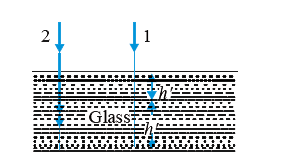A ray of light incident at the pole at angle 25∘ will be reflected at an angle 25∘
To determine whether the statement "A ray of light incident at the pole at angle 25° will be reflected at an angle 25°" is true or false, we can analyze the situation step by step.
1. Understanding the Incident Ray:
- The incident ray is the ray of light that strikes a surface. In this case, it strikes the pole at an angle of 25°.
2. Identifying the Angle of Incidence:
- The angle of incidence (I) is defined as the angle between the incident ray and the normal (a line perpendicular to the surface) at the point of incidence. Here, the angle of incidence is given as 25°.
3. Applying the Law of Reflection:
- According to the law of reflection, the angle of reflection (R) is equal to the angle of incidence (I). This means that if the angle of incidence is 25°, the angle of reflection will also be 25°.
4. Conclusion:
- Since the angle of reflection is equal to the angle of incidence, we can conclude that the ray of light will indeed be reflected at an angle of 25°.
Final Answer:
The statement is True.
---
- The incident ray is the ray of light that strikes a surface. In this case, it strikes the pole at an angle of 25°.
- The angle of incidence (I) is defined as the angle between the incident ray and the normal (a line perpendicular to the surface) at the point of incidence. Here, the angle of incidence is given as 25°.
- According to the law of reflection, the angle of reflection (R) is equal to the angle of incidence (I). This means that if the angle of incidence is 25°, the angle of reflection will also be 25°.
- Since the angle of reflection is equal to the angle of incidence, we can conclude that the ray of light will indeed be reflected at an angle of 25°.
The statement is True.
Similar Questions
A ray of light is incident at an angle of 60∘ on one face of a prism of angle 30∘. The ray emerging out of the prism makes an angle of 30∘ with the incident ray. The emergent ray is
View SolutionA ray of light is incident on the surface of seperation of a medium at an angle 45∘ and is refracted in the medium at an angle 30∘. What will be the velocity of light in the medium?
View SolutionA ray of light incident at the ................... (focus/pole) is reflected at the same angle with the principal axis
View SolutionA ray of light-is incident on glass at the polarising angle ip. Find the angle between the reflected and refracted rays.
View SolutionA ray of light is incident at an angle i from denser to rare medium. The reflected and the refracted rays are mutually perpendicular. The angle of reflection and the angle of refraction are respectively r and r'. Then the critical angle will be:

View SolutionA ray of light is incident at an angle of 60∘ on the face of a prism having refracting angle 30∘. The ray emerging out of the prism makes an angle 30∘ with the incident ray. Show that the emergent ray is perpendicular to the face through which it emerges.
View SolutionA ray of light is incident at an angle of 60∘ on the face of a prism having refracting angle 30∘. The ray emerging out of the prism makes an angle 30∘ with the incident ray. Show that the emergent ray is perpendicular to the face through which it emerges.
View SolutionA ray of light is incident at an angle of 30∘ with the plane of a plane mirror. Find the angle of reflection.
View SolutionOn a plane mirror, a ray of light is incident at an angle of 30∘ with horizontal . To make the reflected ray vertical , at what angle with horizontal must a plane mirror be placed ?

View SolutionShow that for a light ray incident at an angle i on getting reflected the angle of deviation is δ=π−2i or π+2i.
View Solution
